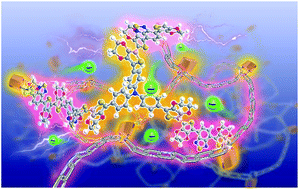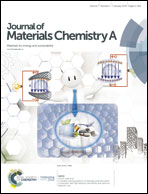A “chain–lock” strategy to construct a conjugated copolymer network for supercapacitor applications†
Abstract
A “chain–lock” strategy was used to build a conjugated polymer network by a facile electrochemical copolymerization method. A classical donor–acceptor monomer, 4,7-bis(2,3-dihydrothieno[3,4-b][1,4]dioxin-5-yl)benzo[c][1,2,5] thiadiazole (DEBT), was selected as the “chain” and a three-branch monomer, tris(4-(2,3-dihydrothieno[3,4-b][1,4]dioxin-5-yl)phenyl) amine (TETPA), as the “lock”. The copolymer shows a hierarchical porous structure, considerable capacitance and excellent stability. This probably contributes to the good electrical conductivity of the π-conjugated skeleton, improved ionic conductivity and structural stability of the porous network. This “chain–lock” polymer with various monomer selections and adjustable molecular structure shows great promise in the energy storage field. This strategy also provides a universal solution for conjugated porous polymer design, which has promising applications in many fields.



 Please wait while we load your content...
Please wait while we load your content...